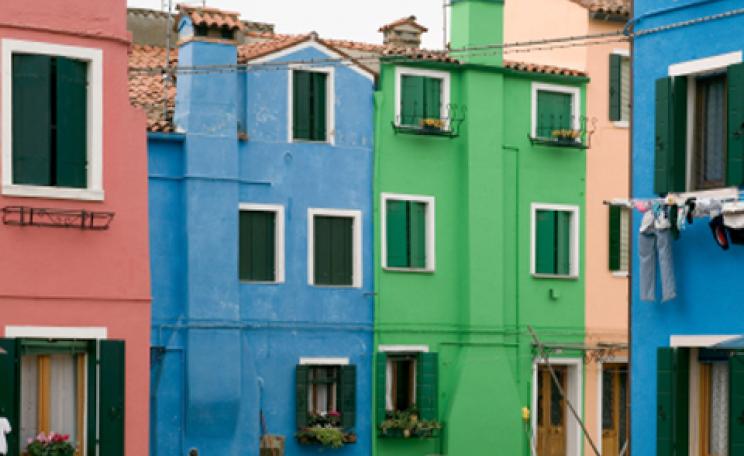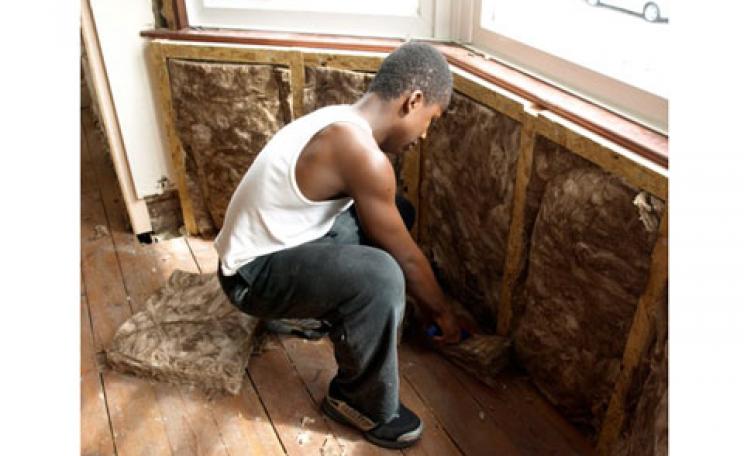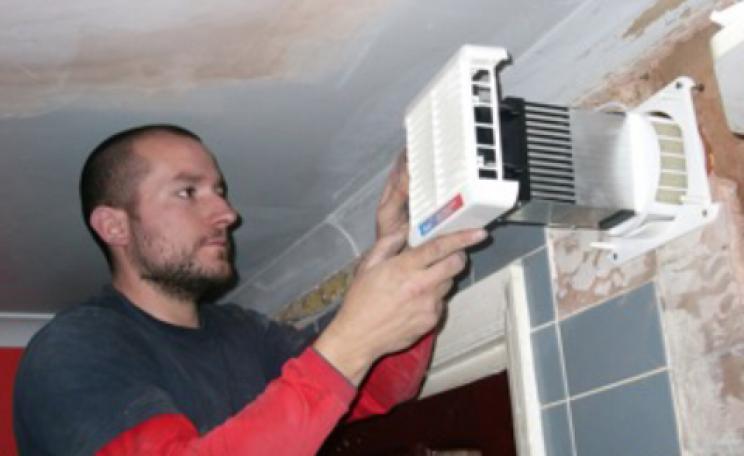A thermal image of our solid-walled Victorian house in winter would show it glowing orange, Ready-Brek style, with all our hard-earned money and more than our fair share of CO2 just flowing out of the walls.
Insulation may not be the sexiest thing to get to grips with in an eco-refurb, but hell, it certainly has passionate advocates. And as it's the best way of keeping warm and reducing your carbon footprint (which is, after all, the point), it's worth doing right.
External vs internal
Even without a cavity wall, you can still insulate. If you have a big expanse of external wall the easiest option is to insulate outside rather than inside. This is a professional measure and works out about £70-120 per square metre. But it will improve the look of your property and add value, and save the most energy as you're basically wrapping your house in a tightly fitting duvet. Another big plus is there is no disruption as the builders are outside.
Internal wall insulation by contrast involves removing the skirting boards, window sills, electric sockets, phone points, radiators and curtain rails from every internal outside wall. Then attaching either rigid insulation boards to the wall (materials range from natural hemp to extruded polystyrene) and plasterboarding over, or laying softer but high density thermal roll (such as sheep's wool or rock wool), between a wooden frame attached to the wall and then boarding and plastering over and putting everything back again.
With professional install it works out at about £45-60 per square metre (£15/sqm for materials). Most builders have done it in new houses but fewer have retrofitted insulation in old houses while occupied, which is much more fiddly.
I toyed with the hybrid option of internal insulation on our front outside wall (the decorative details make external insulation tricky) and external insulation on the back where we'd got a bigger wall expanse. But after discussions with the ever-patient guys at Knauf who do both systems (so I reckoned they had no bias), we decided external insulation wasn't suitable because our short roof overhang meant the insulation would stick out beyond the tiles and to counter that would be tricky and expensive.
'Magic wallpaper' and other solutions
Multiple options on the whole refurb were making my head spin. I called a sustainability consultancy I'd met at Ecobuild, Hatch Sustain, who came to visit. We had useful discussions about the whole house. They suggested electric underfloor heating in the kitchen - the best option for a small space and apparently quite energy efficient (but will we really need it when the kitchen's insulated?), LED lighting for the most used lights, under floor insulation for our draughty suspended timber floors versus reverting to carpets (not with loads of kids in the dining area you don't), and yet more wall insulation solutions like thermal render (thinner than external insulation) and insulating paint (but is thermal masonry paint possible and wouldn't it reflect the heat out?).
 But their main suggestion was to use a 10mm flexible thermal wall liner instead of the full internal wall insulation system.
But their main suggestion was to use a 10mm flexible thermal wall liner instead of the full internal wall insulation system.
As it's just wallpapered on it's much cheaper and less disruptive, and you can then paint over it with insulating paint (yes, it's possible), and put any money you save into photovoltaic (PV) solar panels, as the Government's generous Feed in Tariff (FiT) scheme pays you 41.3p per kw just for having the panels and any surplus you don't use can be sold to the grid at 3p per kw, providing a yearly income for more eco-refurbing or whatever you like.
They worked out eight panels would produce around 1632 kilowatt hours (kWh) a year, which could earn us £674 a year (index-linked) from the Feed in Tariff, rising to £1,370 in year 25 - that's a 10 per cent return. Assuming we use all of the electricity provided we would save £7140.18 over 25 years. Add this to the FiT rate it gives £31,714.31, or £1268.57 per annum, a return of a quite incredible 13.35 per cent and probably more depending on fuel price rises.
It was an exciting thought. I put a call in to Craig O'Donnell, Business Development Manager for Residential Refurbishment at Knauf to break the news of my new thermal wallpaper-PV idea, which would mean no internal wall insulation. He wasn't impressed: 'They call it "magic wallpaper" you know! Well I don't know about you but I don't believe in magic!'
All about U-values
Craig sent me the comparative U-values of different types of insulation (the measure of how thermally effective something is - the lower the U-value the better) and it all became clear.
If I am serious about this (and I am), I need to do proper insulation of 50-100mm, the more the better. A solid brick wall has a U-value (the measure of heat transfer) of about 2.0. A thermal wall liner is better than nothing thermally, but is equivalent to just adding another layer of plasterboard both with a U-value of about 1.48 (and plaster board is a lot cheaper and more durable). Internal wall insulation of 75mm would bring the U-value to 0.35 (improving thermal performance by 80 per cent)
There are products which are only 5-10mm thick and highly thermal, like Aerogel's Spacetherm insulating blanket but seeing as it uses nanotechnology and is used by spaceships, the price is similarly stratospheric.
Back to basics
Then there was my husband's killer logic: 'If we spend our money on PV panels they're on the roof where we can't see them. But our kitchen will still be mouldy, freezing and disgusting - and we see it everyday!' Our lights and TV might be PV-lit for free but our house would still be guzzling gas for heating, since the magic wallpaper's magical properties are so limited (30-45 per cent of the house's heat is lost through solid walls). And our electricity bill isn't that high anyway as most of our appliances are A-rated and I'm an eco-Fuhrer about turning everything off.

Hubby was right. I had been seduced by PV without ‘getting our house in order first'. I'd forgotten that our £10k eco-refurb fund is to make the house more energy efficient while also making it more habitable. And it needs to be spent now, not in small yearly increments.
Here's the grim picture: wallpaper peeling off in every room because of condensation and lack of ventilation (draughts are not appropriate ventilation as they are not necessarily where you need them and our old double glazing doesn't have trickle vents), a kitchen with two outside walls that acts as a house chiller (in the day the adjoining lounge can be several degrees colder than our garden), and a bedroom above the kitchen which is similarly cold and mouldy.
Hatch Sustain was right to say £5-10k will give you a better return on your roof than in the bank. But it has to be a spare £5-10k. I was getting distracted from reducing my carbon footprint by the thought of improving my financial one.
The golden solution
I started again. A sustainable building friend recommended an eco-refurb project management company, Parity Projects. One of their surveyors, Chris Newman, came round with a laptop, a camera and an infrared measure, asked me some eminently sensible questions about the house, our energy use, our lifestyles, our gadgets and appliances plus priorities for the refurb, and put all the answers into his software there and then. A few days later an impressively detailed but easy-to-read 40-page report came back with graphs and stats and readable copy all in glorious technicolor.
After several months of head-swirling research I had hit gold. Their recommendations reaffirmed my original decision for internal insulation. Now I just have to find a builder, but as Knauf provides training to everyone who fit their products (homeowners or builders) I am confident anyone I choose should be able to do it right. Even I could apparently, if I had the tools and the time. Parity provided a whole host of other suggestions too, some of which I'd never come across, with calculations for each measure giving cost, annual fuel saving, annual carbon saving, payback period plus bespoke recommendations for our house. I am in eco-refurber's heaven.
I'll go into the details of Parity's precise recommendations next time, but suffice to say, although I might still occasionally dream about solar panels, the reality is that as good an insulation system as you can afford, strategic ventilation and a few energy efficiency tweaks are the golden nuggets for our house - and they probably are for yours too.
Links to similar things happening:
- Rethinking Housing Refurbishment
- The Yellow House
- CAT
- www.salford.ac.uk/news/details/1140
- http://refurbn16.com
- www.victeri.co.uk/default.aspx
- www.bsria.co.uk/news/low-carbon-refurb
And a very useful resource: www.greenbuildingbible.co.uk
| READ MORE... | |
 |
GREEN LIVING Turning our Victorian terrace into an ecohome: part one One family's journey to turn a draughty, turn-of-the-century terrace into a snug paragon of eco efficiency |
 |
GREEN LIVING Wrap up your home Insulating your home will save energy and money. This simple guide will show you where to start and what material to use |
 |
NEWS ANALYSIS Low-tech retrofit experiment could transform social housing The Greening-the-Box initiative aims to demonstrate that retrofitting can transform hard-to-heat housing association and council properties into models of low-tech sustainability and fuel efficiency - with almost zero heating |
 |
INTERVIEW LSE's Anne Power: my recipe for 80 per cent energy savings in your home Anne Power, Professor of Social Policy Housing and Social Exclusion at the London School of Economics, on why nearly all homeowners can afford to insulate properly, and how to save energy on a budget |
 |
SPECIAL CONTENT Ecologist guide to greening your home Greening your home can save you energy and money as well as making it healthier and lowering its carbon footprint |







